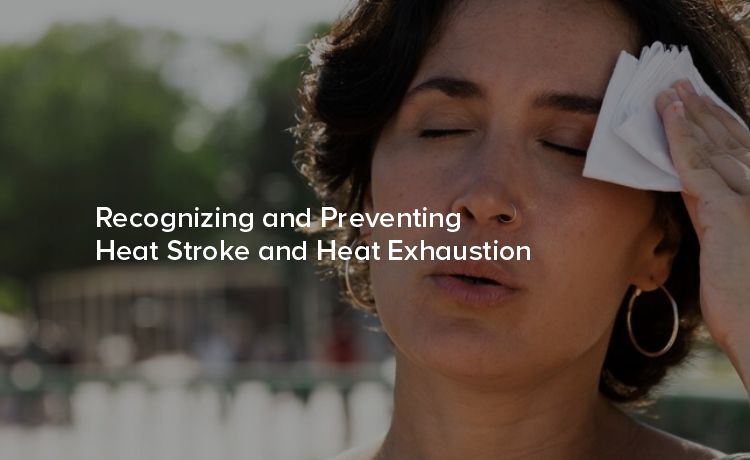
Recognising and Preventing Heat Stroke and Heat Exhaustion
Heat can be dangerous. Whether you're enjoying a sunny day at the beach or engaging in outdoor activities, prolonged exposure to high temperatures can lead to serious heat-related illnesses such as heat stroke and heat exhaustion.
What Are Heat Stroke and Heat Exhaustion?
Understanding Heat-Related Illnesses
Heat exhaustion and heat stroke are conditions caused by the body’s inability to properly cool itself. While they are related, they differ greatly in severity and the way they affect the body.
- Heat exhaustion is a less severe condition, but it still poses health risks. It occurs when your body overheats and loses too much water and salt, typically through excessive sweating.
- Heat stroke, on the other hand, is a medical emergency. It happens when your body can no longer regulate its temperature, causing a rapid rise in body heat that can damage organs if untreated.
Understanding these differences is crucial to prompt recognition and appropriate action.
Who’s Most at Risk?
Anyone can develop heat-related illnesses, but some people are more vulnerable than others, including:
- Children under 4 and adults over 65 (their bodies adjust less effectively to heat)
- People with chronic illnesses such as diabetes or heart disease
- Those engaged in prolonged physical activity, such as athletes or outdoor workers
- Individuals taking medications that affect hydration or temperature regulation
Now that we understand the basics, let's explore the specific signs and symptoms of heat exhaustion and heat stroke.
Recognising the Symptoms
Signs of Heat Exhaustion
Heat exhaustion can develop quickly and may cause symptoms such as:
- Heavy sweating
- Muscle cramps
- Fatigue or weakness
- Nausea or vomiting
- Dizziness or light-headedness
- Cool, clammy skin
- Rapid, yet weak, pulse
- Headaches
If you or someone around you exhibits these symptoms, take action to cool down immediately (more on that later).
Signs of Heat Stroke
Heat stroke is a more severe progression of heat exhaustion and requires urgent medical attention. Symptoms include:
- Body temperature exceeding 40°C (104°F)
- Hot, red, dry, or damp skin
- Rapid and strong pulse
- Confusion or disorientation
- Seizures
- Loss of consciousness
The onset of heat stroke can be sudden, escalating health risks quickly. If someone is experiencing these symptoms, call emergency services and take immediate steps to cool them down.
Preventing Heat Stroke and Heat Exhaustion
Hydration is Key
One of the simplest and most effective ways to combat heat-related illnesses is by staying hydrated. Aim to drink water regularly, even if you don’t feel thirsty, especially during prolonged exposure to heat. Electrolyte-replenishing drinks can also help replace lost salts.
Tips:
- Keep a water bottle with you at all times.
- Avoid excessive caffeine or alcohol as these can dehydrate you.
- Boost hydration with fruits high in water content like watermelon, oranges, and cucumbers.
Dress for the Heat
What you wear can make a big difference in managing your body temperature.
Wear:
- Lightweight, loose-fitting clothing to allow airflow.
- Light-coloured fabrics to reflect sunlight.
- A wide-brimmed hat or cap to provide shade.
Sunscreen with an SPF of 30 or higher is also essential to prevent sunburn, which affects your body’s ability to cool down.
Plan Activities Wisely
Limit intense physical activities during peak heat hours, typically between 10 a.m. and 4 p.m. If you must be outdoors, take regular breaks in shaded or air-conditioned areas.
For outdoor workers and athletes:
- Gradually acclimatise to working out or engaging in physical activity in the heat.
- Use the buddy system to ensure someone is looking out for any warning signs of heat-related stress.
Recognise Early Signs of Trouble
Educating yourself and others on the early signs of heat exhaustion can stop the condition from worsening. Acting quickly when symptoms first appear can prevent deterioration into heat stroke.
First Aid for Heat Exhaustion:
- Move the affected person to a cooler place, Ideally under the fan.
- Encourage them to drink water or a hydrating beverage.
- Remove excess clothing to help cool their body.
- Apply cold compresses or have them take a cool shower if possible.
Heat Stroke Requires Immediate Action
If someone shows symptoms of heat stroke, treat it as a medical emergency. While waiting for help to arrive, take these immediate steps to cool the person down:
- Move them to a shaded or air-conditioned area.
- Cool their body by giving cold water, applying ice packs, ensuring that the affected person is under the fan or wrap with sheets that are dipped in ice water.
- Monitor their condition closely and avoid giving them anything to drink if they are unconscious.
How to Stay Prepared During a Heatwave
Heatwaves can put additional strain on health systems and individuals. Here are a few extra precautions to take during extremely hot periods:
- Check on vulnerable individuals such as elderly family members, neighbours, or anyone living alone.
- Stock up on essentials like water, cooling packs, and sunscreen before high heat is forecast.
- Use air conditioning responsibly to avoid power outages while maintaining a safe indoor environment.
- Follow weather updates to stay informed about heat advisories and alerts in your area.
Conclusion
Adapting to hot environments doesn’t mean giving up your favourite summer activities, but it does require awareness and action. Recognising the warning signs of heat exhaustion and heat stroke, staying hydrated, and planning wisely can significantly reduce risks.
